Jefferson Middle School Students Experience Cool Hands-On Science, Courtesy of the MCBees
December 12, 2018
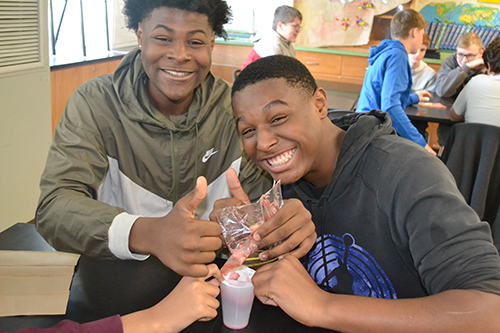
Two Jefferson Middle School students filter the liquid from the strawberry puree they made in order to extract the DNA.
Extract DNA from strawberries. Look at human cheek cells via a microscope. Make paper helicopters. These are some of the fun, hands-on STEM activities Jefferson Middle School eighth graders are getting to do courtesy of the MCBees, a graduate student organization from Illinois’ School of Molecular and Cellular Biology (MCB). So, a couple of times a month from October 2018 through May 2019, MCB Ph.D. students (and postdocs) are putting their research on hold for an hour or so in order to share their passion for science with Elizabeth Wheatman’s and Sammy Yoo’s eighth grade students. The two science teachers appreciated the MCBees’ spring 2018 activities so much that they invited them back for the entire 2018–2019 academic year.
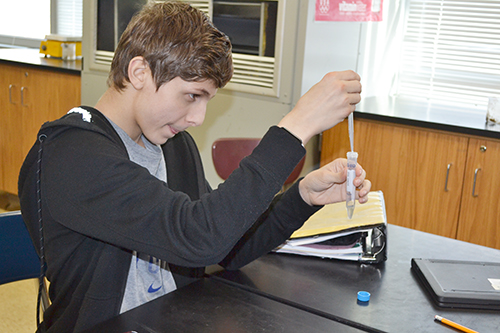
Above: A student adds a reactant to a food sample during the "What's in Your Food?" activity.
Below: A Jefferson Middle School student exhibits the tube of strawberry DNA she isolated.
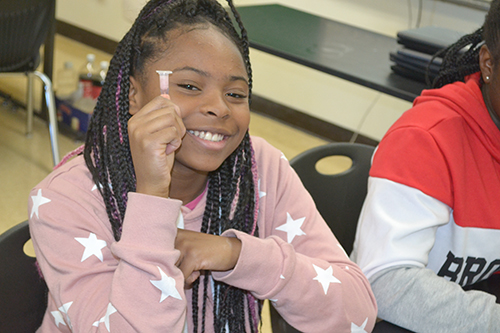
The idea of the partnership is to expose the eighth graders to fun hands-on activities that go beyond their science curriculum. So on October 29th, the Jefferson students isolated DNA from strawberries. On November 30th, during the “What’s in Your Food?” activity, the students tested various food samples to see which would have the most carbohydrates and/or proteins. (Big surprise, Coke had the most carbs and, of course, 0 proteins). One volunteer who helped out with the activity, second year Microbiology grad student Roy Rodriguez-Carrero, was hopeful that while experiencing some of the different chemical methods used to determine the carbohydrate and protein content of solutions, the activity would help the students to better understand “the importance of what kinds of food they eat.”
Similarly, Preeti Sharma, who recently completed her PhD in Biochemistry and now works as a postdoc, hoping that as a long-term effect of the activity, students would be inspired to “further analyze their food intake and strive towards a more balanced and healthy diet,” and that the “hands-on experimental experience along with instant colorful results spiked their interest in science.”
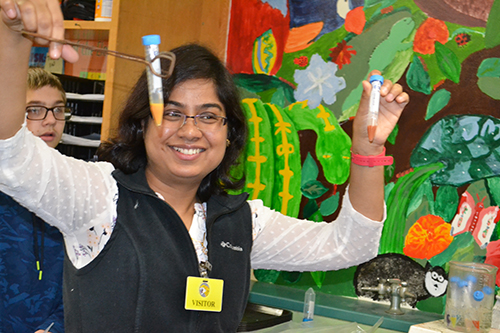
Preeti Sharma shows Jefferson Middle School students the differnt levels of carbohydrates contained in orange juice (the left tube) and coke (the right tube)..
Sharma, whose research in cancer immunotherapy uses protein engineering to modify properties of antibodies and T cell receptors for therapeutic and diagnostic applications, was one of the driving forces behind the “What’s in Your Food?” activity. Indicating that she has “always been interested to spark interest in science among kids,” she thought it would be helpful to teach students about the nutritional content of their food, hopefully inspiring them to "eat healthy and be healthy!” She describes how she came up with the idea for the activity.
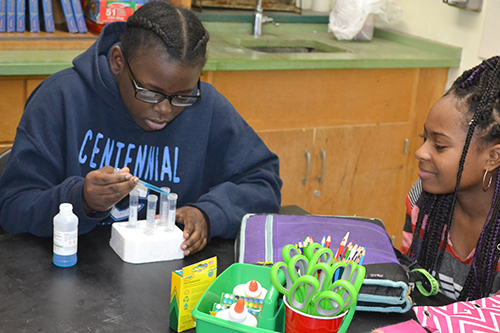
Students add reactants that will change the color of a solution to show what nutritional components are in it.
“Since I am a biochemist, I felt that the use of colorimetric reactions, which would generate some fun colors upon reacting with certain components of food (for example, shades ranging from yellow to red if food contained sugars, and shades ranging from pink to purple if food contained proteins), would be a great way to teach students about the nutritional composition of their food, and subsequently inspire them toward a more healthy and balanced diet.”
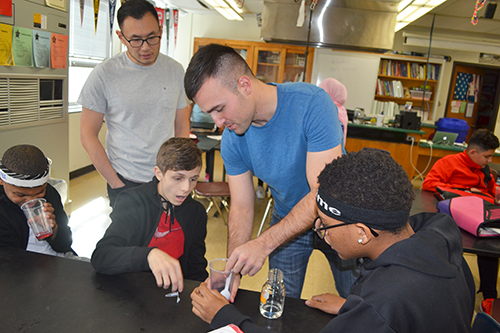
Jefferson science teacher Sammy Yoo (second from the left) watches as MCB grad student Dylan Blana (center) helps Jefferson eight graders isolate DNA from strawberries.
On December 10th, the students observed different colors that are present in spinach leaves, markers, and food coloring gels or liquids, plus learned how to separate out colors using a simple technique called chromatography. Some additional activities planned for the 2019 spring semester include: examining human cheek cells under a microscope, experimenting with several different chemical reactions, learning about the different states of matter, and making paper helicopters.
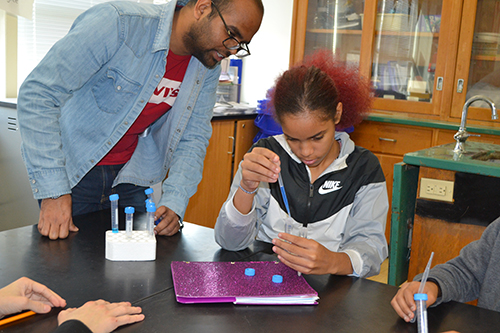
Above: Pradeep Kumar assists a student while she adds a reactant to her solution.
Below: MCB PhD student Pooja Agashe (left) watches as a student places the DNA he isolated into a small container to take home.
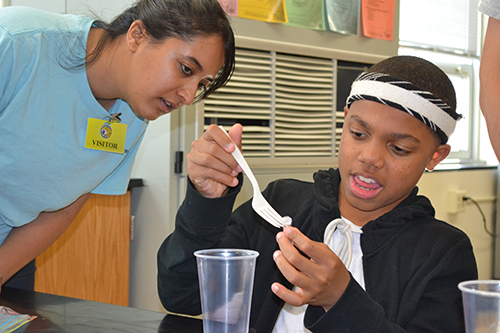
Helping to organize the activities, including soliciting volunteers via their listserv of 400+ MCB grad students, is Pradeep Kumar, one of the MCBees’ Outreach Coordinators. And while Kumar says the activities at Jefferson aren’t intended to be dumbed down versions of MCB students’ research, the extracting DNA from strawberries activity was actually pretty close to what Kumar does. While Kumar doesn’t work with strawberries, he says he and some of his peers use the same protocol to isolate DNA from different cells, such as animal or bacteria cells. A third year PhD student in MCB’s Cell and Developmental Biology department, Kumar studies how DNA is organized in the nucleus. He indicates that the DNA from a single cell is about two meters long, “but it is packed into a tiny nucleus a few micron in size,” he says. “So how does that happen?” That’s what he’s trying to discover through his research.
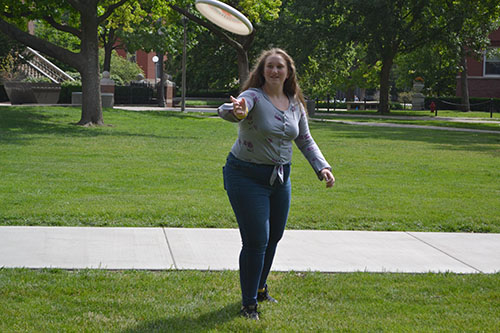
Students add reactants that will change the color of a solution to show what nutritional components are in it.
So what’s the benefit of doing activities like this with middle schoolers? Kumar says that while the kids might have heard about some of the science addressed in some of the activities they’re doing, they’ve probably never had the opportunity to actually do hands-on activities related to the topics. For example, while they probably know a little about DNA, they might not know how it’s analyzed. So the activity where students isolated the DNA from strawberries “gave them an idea how scientists isolate DNA from some sample, and how it will look in a tube.” He adds that the activities he and the others are doing gives the younger students an opportunity to visualize whatever it is they’re learning now.

A Jefferson Middle School student removes the solidified DNA from his strawberry solution.
In fact, Jefferson teacher Elizabeth Wheatman reports that the extracting-DNA-from-strawberries activity was “perfect!”
“Because we just finished our genetics unit last week,” she continues, “so they go to extract DNA and see what it looks like and kind of get a refresher of everything they learned in the genetics unit.”
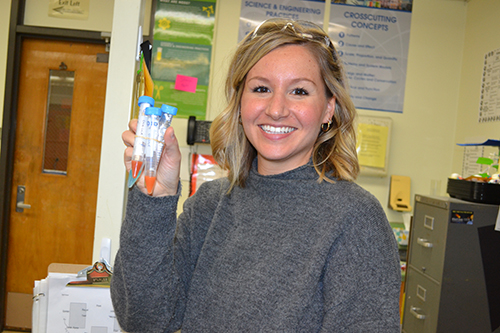
Jefferson eighth grade science teacher Elizabeth Wheatman exhibits some of the samples her students tested during the "What's in Your Food?" activity.
Wheatman shares what she believes is the benefit of bringing Illinois folks like the MCBees into the classroom—to serve as role models: “Students can see peers that are closer in age to them, other students, and see how they're passionate about science and what they're studying and then do some really cool hands-on activities.”
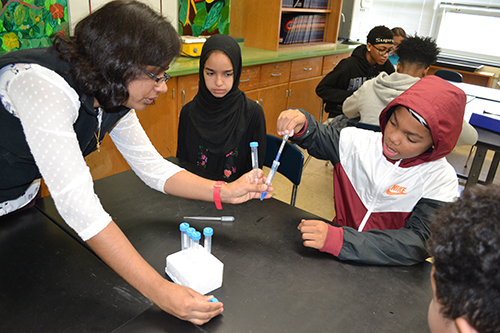
Preeti Sharma helps a student put reactant into a food sample tube duing the "What's in Your Food?" activity.
MCB postdoc Preeti Sharma also believes that having Illinois grad students visit local schools like Jefferson, "will hopefully inspire more and more students to get interested in math and science and subsequently lead them to a career in the STEM fields. The graduate program at the University of Illinois in general, and the school of MCB in particular, consist of students from diverse backgrounds, driven in science and motivated to teach and share, which, in my opinion, represents the ideal group of people to inspire the next generation of scientists," she says.
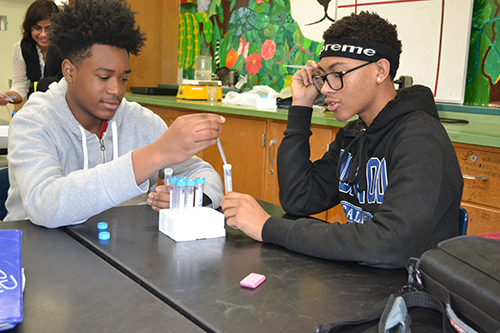
Students add reactants that will change the color of a solution to show what nutritional components are in it.
Kumar, who’s been participating in almost all of the MCBees’ outreach events since its inception, explains why he finds outreach to be rewarding. While he personally enjoys doing the events, he also admits that he hopes to pique students’ interest in science. “I'm a first-generation college graduate,” he acknowledges, “so I'm passionate about outreach and trying to help make people more interested in science…So I feel this will be a good opportunity for me to interact with people and share my curiosity or interests with them.”
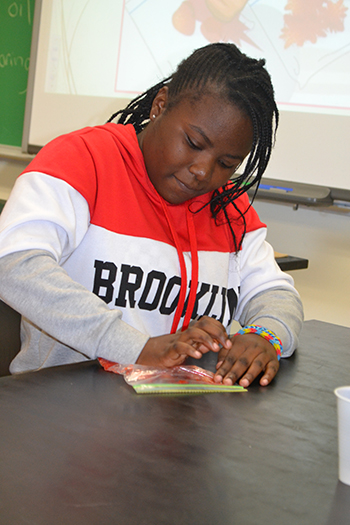
A student mashes strawberries so that she can collect the DNA from it.
What kind of impact do Kumar and his colleagues think their activities are having on the middle schoolers? For one, according to a small survey they administer after the activities to get feedback from the students, “There were a few students who actually wrote that they're more interested in science now...definitely a few students who said they're more interested now. I believe it's having a positive impact.”
Regarding his goal of introducing the kids to things they might not get exposed to at school, he relates how last year, he borrowed some drosophila melanogaster fruit flies from MCB Associate Professor Rachel Smith-Bolton, who uses them in her research. “So I showed those flies to the kids, and some of them were really interested that we can study these flies and understand about human diseases…Those kinds of things these kids might not get to do in their curriculum. They'll never get to see a fly help people, be used to identify different things. It was a good experience. I think we are somehow having some impact on them,” and he believes that if it’s not right now, at some point, down the road, interest in science will kick in.
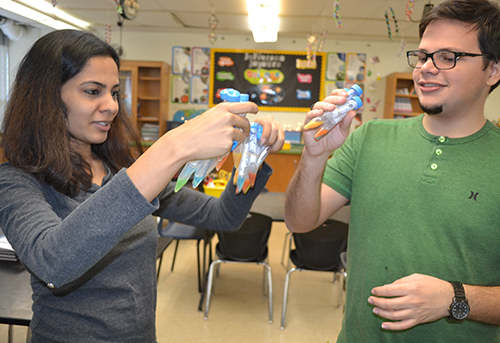
MCB students Surghi Jain and Roy Rodriguez examine the food samples which have changed colors, exhibiting whether they contain high levels of carbohydrate or protein.
One MCB student who is helping out with the outreach is Roy Rodriguez-Carrero, a second year grad student in Microbiology who is studying genes that modify the enzyme methyl-coenzyme M reductase. He reports getting involved in order to “gain experience in communicating science and demonstrating scientific methods to a younger audience,” in hopes that it will help to “diminish the perceived barrier between school-level education and university-level education.”
Another MCB participant who is helping out at Jefferson is Rajashekar Iyer, a postdoc who just got his PhD in cell biology and neuroscience and whose plans for the future include research and teaching at a university. He's participating because of the impact similar outreach events had on him as a youngster.
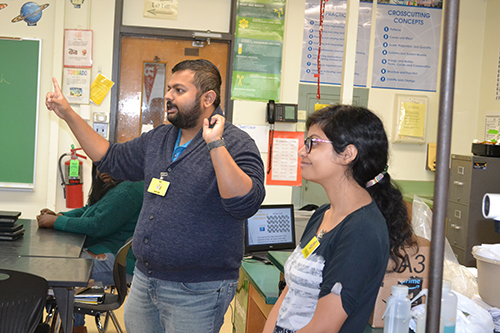
MCB postdoc Raji Iyer and PhD student Anshika Gupta explain the strawberry DNA isolation activity to the middle school students.
“I remember the first time I got to do some of the cool biology that I ended up doing in school, and it was a very informative experience. Learning about DNA, for instance, was really exciting, and it shaped who I am now. I think getting the chance to do that for kids who are right now thinking about what they want to do is really fun.”
Story and photos by Elizabeth Innes, Communications Specialist, I-STEM Education Initiative.
More: Graduate STEM Outreach, 6-8 Outreach, MCBees, Jefferson Middle School, 2018
For more I-STEM articles about the MCBees, please see:
- At NGS’ Science Social Café, MCBees Women Serve as Role Models, Exemplify Careers in Science
- MCB’s Jeremiah Heredia: Passionate about HIV-1 Research, STEM Outreach to Underserved
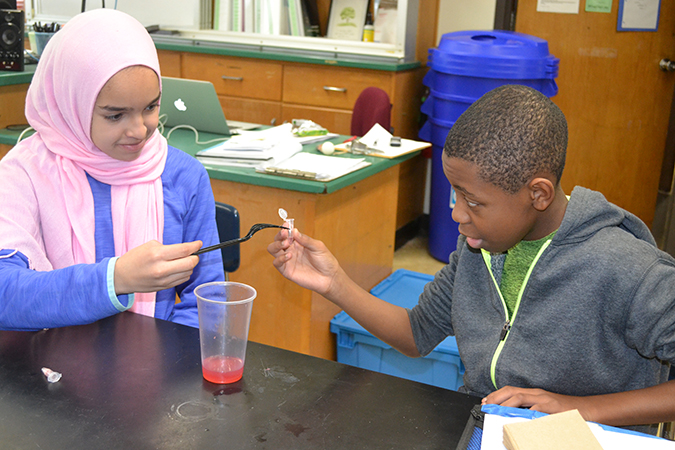
Above: Students remove the solidified DNA from their strawberry solution.
Below: MCB PhD students Anshika Gupta, Rajashekar Iyer, Pooja Agashe, and Dylan Blana arrive to do an outreach with eighth graders at at Jefferson Middle School.
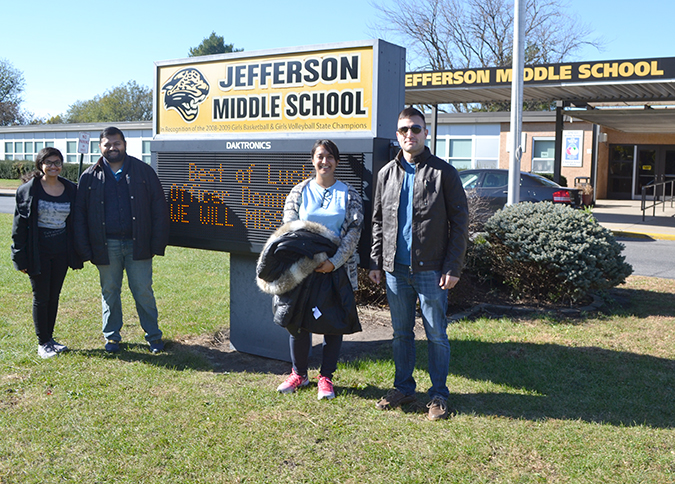













.jpg)
















